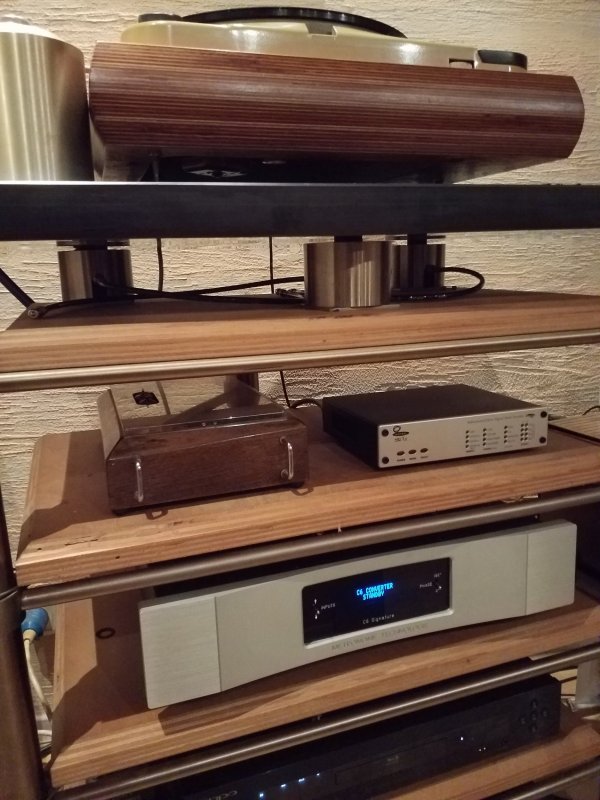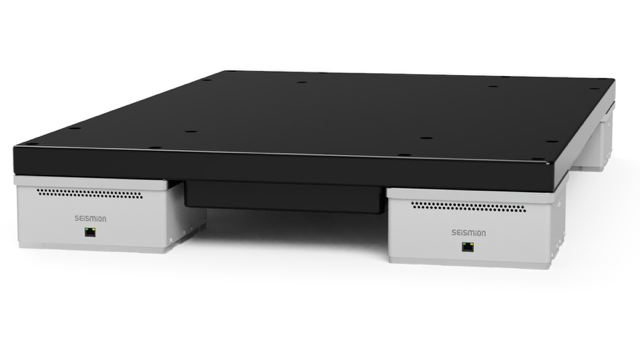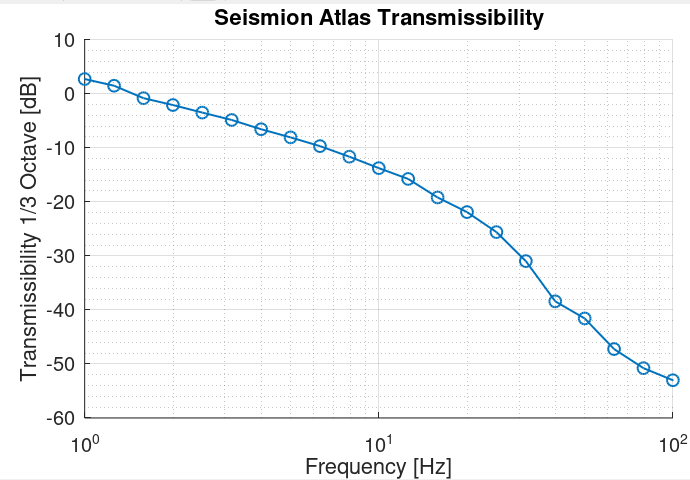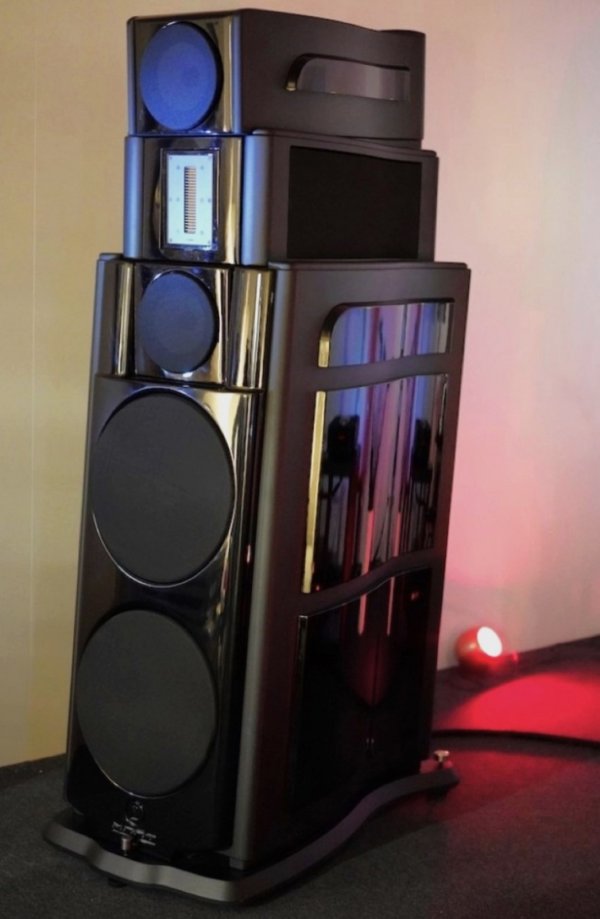Thanks, yes I remember a video of Michael Fremer where he touched his Minus k platform and it went up and down quite far but veeery slowly. But compared to a Thixxar/Accurion, yours is also softer it seems from the Chinese video. But I don’t see this as a disadvantage for a record player. I just wonder how electron microscopes or similar can be operated on slightly wobbly platforms.
Seismion - new active isolation platform from Germany
- Thread starter TLi
- Start date
You are using an out of date browser. It may not display this or other websites correctly.
You should upgrade or use an alternative browser.
You should upgrade or use an alternative browser.
First of all, you should ask yourself what vibrates below 4 Hz in your house. The only thing that comes to mind is tectonic earth movements. I think when that happens, you have other problems and you don't listen to music. JokeAm I correct that no passive solution works (enough) below 4Hz?
I have been using the air spring solution for 13 years. OK, you have to refill the air every 4 weeks. But that is the only negative aspect for me, still the best buy i ever done.
everything.First of all, you should ask yourself what vibrates below 4 Hz in your house
yes. and it turns out that is significant.. The only thing that comes to mind is tectonic earth movements
this falls into the category of "until you hear it, you don't realize what is going on". especially listen to a double bass or cello in a full frequency recording with properly executed active in and out of the system. especially with vinyl. big difference in realism. i have found that i need to turn down some recordings without active since the feedback causes bass distortion when a system can be linear in the lowest octaves. not all systems push the linearity ceiling, but some do..I think when that happens, you have other problems and you don't listen to music
. Joke.
until you use active devices, it's hard to appreciate what the performance ceiling might be for that approach. the earth is constantly in motion objectively.I have been using the air spring solution for 13 years. OK, you have to refill the air every 4 weeks. But that is the only negative aspect for me, still the best buy i ever done.
observe how an electron microscope installed in a ground floor facility on a sold table becomes usable with active, useless without it. easily observable. and our ears (probably) exceed the electron microscope in perception.
visit me, and we can turn all five of them off, and then turn them on. enough said. my room has a concrete floor, i'm in a separate building from my home, in the mountains, not close industry or roads. yet it makes a big difference.
and agree that passive can be wonderful. but passive floats and settles....to some degree, active is many degrees stiffer....and can start and stop. passive devices have a degree of character, something added or subtracted. properly executed, active does not do this. OTOH some gear is voiced for some resonance, so active is no universal solution. and some gear has too much self noise to result in a net performance gain. but most gear is not like that.
Last edited:
…this would be a good question to Seismion. As far as I heard from experienced folks, this low region does make a difference for record players, but I don’t know how those frequencies are caused apart from the „house moving frequency“ or such things. For turntables small things can make big differences.For example, I wouldn’t want to ever pass on a levitated platter without pivot contact anymore for resolution/3D reasons. I hope for similar effects by better isolation + bass advantages.
I'm happy for you that it's working well for you. Guess what kind of table an electron microscope stood on before there was an active base. You have 3 attempts. I don't want to say anything bad here, I take my hat off to engineering.everything.
yes. and it turns out that is significant.
this falls into the category of "until you hear it, you don't realize what is going on".
until you use active devices, it's hard to appreciate what the performance ceiling might be for that approach. the earth is constantly in motion objectively.
observe how an electron microscope installed in a ground floor facility on a sold table becomes usable with active, useless without it. easily observable.
visit me, and we can turn all five of them off, and then turn them on. enough said. my room has a concrete floor, i'm in a separate building from my home, in the mountains, not close industry or roads. yet it makes a big difference.
and agree that passive can be wonderful. but passive floats and settles....to some degree, active is 500x stiffer....and can start and stop.
The material on which a device stands and how it is connected are crucial for the sound.
Cplusw in germany made gorgeous passive systems
Optische Tische | cplusw GmbH
Last edited:
my Rockport Sirius III turntable designed in 1995, used a passive air bladder table designed for Electron Microscopes. active was not yet a thing in 1995. science moves on.I'm happy for you that it's working well for you. Guess what kind of table an electron microscope stood on before there was an active base. You have 3 attempts.
agree totally. context is everything.I don't want to say anything bad here, I take my hat off to engineering.
The material on which a device stands and how it is connected are crucial for the sound.
agree that passive can be very high performance. that is what i use for my Wadax and am very happy.Cplusw in germany made gorgeous passive systems
Optische Tische | cplusw GmbH
www.cplusw.de
When I first heard about the DIY air spring solution at a friend's house in 2010, I quickly built something like that myself. The German AAA analog forum was a buzz when we introduced it. We tried out almost all materials as a base for the air spring. From metals, wood to multi-layered soundproof glass. We had the most natural sound with slate. 3 air springs of type SLM 1 require at least 110kg mass load to function from 3.5 Hz. e.g. turntable 35kg + 75kg slate plate.my Rockport Sirius III turntable designed in 1995, used a passive air bladder table designed for Electron Microscopes. active was not yet a thing in 1995. science moves on.
agree totally. context is everything.
agree that passive can be very high performance. that is what i use for my Wadax and am very happy.
I know ~ 15 people who are still happy with it today with this solution
Sorry off topic
P.S
after that cplusw has added slate as a base in the program a little later for turntable users
pure coincidence.
Last edited:
i think alternatives to active are completely on topic. i have seriously considered the passive air bladder Stacore for my CS Port turntable....which i expect would have too much self noise for active, and it's footprint is too large for active shelves. the Stacore is very well executed (more advanced than a Vibraplane). however not cheap when i would need a custom size. my 200 pound CS Port would need a special version for heavy units. and also; not cheap to ship from Poland. the Stacore is more than a simple air bladder. i would choose that mostly instead of a Minus K or some very spendy rack system i would be forever wed to. it's a particular answer to a particular question. and it would not be tweaky. i'm about solutions, not dogma. my mind is open to the best performance.When I first heard about the DIY air spring solution at a friend's house in 2010, I quickly built something like that myself. The German AAA analog forum was a buzz when we introduced it. We tried out almost all materials as a base for the air spring. From metals, wood to multi-layered soundproof glass. We had the most natural sound with slate. 3 air springs of type SLM 1 require at least 110kg mass load to function from 3.5 Hz. e.g. turntable 35kg + 75kg slate plate.
I know ~ 15 people who are still happy with it today with this solution
Sorry off topic
however; with the cost of the Seismion being equivalent or less than a passive Stacore, i'd choose the active Seismion if it were the right fit for the situation. and less hassle than the Stacore as you don't need to check the pressure of the bladders from time to time.
Last edited:
Unfortunately, my budget is not enough for that. That's why I've been looking for a DIY solution, planned slate plate + air springs, hose and valves ~600 euros. Also very important in case there is a loss of pressure. In the photo, the stainless steel sleeves around the air spring effectively prevent it from tipping over.i think alternatives to active are completely on topic. i have seriously considered the passive air bladder Stacore for my CS Port turntable....which i expect would have too much self noise for active, and it's footprint is too large for active shelves. the Stacore is very well executed (more advanced than a Vibraplane). however not cheap when i would need a custom size. my 200 pound CS Port would need a special version for heavy units. and also; not cheap to ship from Poland. the Stacore is more than a simple air bladder. i would choose that mostly instead of a Minus K or some very spendy rack system i would be forever wed to. it's a particular answer to a particular question. and it would not be tweaky. i'm about solutions, not dogma. my mind is open to the best performance.
however; with the cost of the Seismion being equivalent or less than a passive Stacore, i'd choose the active Seismion if it were the right fit for the situation. and less hassle than the Stacore as you don't need to check the pressure of the bladders from time to time.
if someone wants to build it, for weight calculation slate 1 cubic meter weighs 2.8 tons (simply length × width x height of the plate.

You have a point, mtemur.I’m glad Tana systems work well with your setup.
IMHO the right way of testing is not comparing the sound between (active platform that you use) active and turned off. The right way is; comparing equipment over active platform and over other passive platform cause active platforms are not made to be operated passively. But anyway we tried Seismion both active and passive and compared when equipment is over another passive platform (Kondo Kaguras over SRA Ohio and over Seismion).
I tried many active and passive isolators together with different spikes and footers in several setups. There are times that I find active isolation not helping the situation. Too much isolation can sound harsh and dry. There are noise and distortion in every system. Some of this noise can be obscured by resonate sound caused by vibrational feedback.
To cut a long story short, a system with too clean a background will expose its distortion more than a blurred system. In some system, it is not a good idea to isolate all environmental vibration. This is my personal experience. But the fault is not on the active isolators, it is the other components of the system.
I actually suggested to Seismion to add an extra function in their future isolators. That is like a volume knot in amplifier which the user can adjust the isolation level. Then we can fine tune the degree of isolation for the best sound.
This suggestion is quite against the scientific mind of engineers in Seismion. More often than not, engineer thinks differently with audiophile. They look at figure and data, we listen to the sound. That's why but they promised to look into it. We shall see.
i think this might be related to gear that does not fully complete notes and decay, in the name of accuracy, somewhat strangling the music, and which depends on normal resonance to fill it out. take that resonance away and it's thread bare. but don't point fingers at the clarity of active. it's garbage in-garbage out. avoid overly clean and ultra detailed gear.You have a point, mtemur.
I tried many active and passive isolators together with different spikes and footers in several setups. There are times that I find active isolation not helping the situation. Too much isolation can sound harsh and dry. There are noise and distortion in every system. Some of this noise can be obscured by resonate sound caused by vibrational feedback.
To cut a long story short, a system with too clean a background will expose its distortion more than a blurred system. In some system, it is not a good idea to isolate all environmental vibration. This is my personal experience. But the fault is not on the active isolators, it is the other components of the system.
I actually suggested to Seismion to add an extra function in their future isolators. That is like a volume knot in amplifier which the user can adjust the isolation level. Then we can fine tune the degree of isolation for the best sound.
This suggestion is quite against the scientific mind of engineers in Seismion. More often than not, engineer thinks differently with audiophile. They look at figure and data, we listen to the sound. That's why but they promised to look into it. We shall see.
it can also work on the other extreme, too much golden glow and that get's exposed as too much, too much. clarity exposing it as less real....not more real.
cables can move things toward these extremes sometimes.
it's all about keeping to gear with natural balance....whatever that might be. then you can let'r rip with active. and as you keep uncovering more of it, it stays musical.
to a degree.....active = truth. good......if you can deal with it.
Last edited:
Can't agree more, Mike.i think this might be related to gear that does not fully complete notes and decay, in the name of accuracy, somewhat strangling the music, and which depends on normal resonance to fill it out. take that resonance away and it's thread bare. but don't point fingers at the clarity of active. it's garbage in-garbage out. avoid overly clean and ultra detailed gear.
it can also work on the other extreme, too much golden glow and that get's exposed as too much, too much. clarity exposing it as not real.
it's all about keeping to gear with natural balance....whatever that might be. then you can let'r rip with active. and as you keep uncovering more of it, it stays musical.
to a degree.....active = truth. good......if you can deal with it.
95% of the time, active isolation is helping and positive. In the remaining 5%, user should look into the problem and find which part is not working.
Good morning to you. Your post was deleted. This is not a discussion about the flaws of vinyl. Please stick to the topic.
Tom
Tom
Did someone try active isolation under speakers? It also should completely isolate a subtenants’ flat from booming bass, right?
...perhaps reduce but surely not eliminate bass transmission to other rooms/structurally connected locations. Still the airborne waves emanating from the drivers to contend with, right?
In fact, Seismion will present our first fully active vibration stabilizer (isolator) for loudspeakers at the High-End in Munich next week! The new "Atlas" system for audio applications is built around our industrial isolators, which are especially designed for dynamic systems in the field of semiconductor inspection. Such applications typically contain moving XY stages, and the task is to stop the platform motions due to the accelererations and decelerations in the shortest time, so that the next measurement can be performed. Beside an extremely fast settling time, the device must be be isolated from the ground vibrations all the time.Did someone try active isolation under speakers? It also should completely isolate a subtenants’ flat from booming bass, right?
These specifications make them the ideal choice for loudspeakers aswell. Below is a rendering of one platform. It has a size of 120x80 cm. Such a set of 4 Atlas systems has a maximum power of 500 Watt, and can therefore generate extremely strong damping/stabilizing forces, while they isolate the platform at the same time from ground vibrations. It is extremely stiff for a typical isolator, since it is designed for payloads up to 4 tons.

Such a speaker stabilizer should very efficiently reduce the vibrations induced into the floor. More importantly, they totally isolate the speakers from ground vibrations, and also suppress the motion of the loudspeaker housing due to the generated sound pressures.
Because of the control forces, the Atlas system has a very high and constant dynamic stiffness, and it does not have any weakly damped resonances.

Passive airspring isolators or typical active isolators would not be useful for this task, since they are very soft and cannot generate the required control forces.
For the High-End in Munich we teamed up with Extreme Audio and CanEVER Audio. In room H2, H07/J11 our new Atlas system is placed under a Sigma Acoustics MAAT loudspeaker (one platform for each speaker).

We are looking very much forward to this world premier, and hope some of you would be able to make it to the show!
Thank you for the information.In fact, Seismion will present our first fully active vibration stabilizer (isolator) for loudspeakers at the High-End in Munich next week! The new "Atlas" system for audio applications is built around our industrial isolators, which are especially designed for dynamic systems in the field of semiconductor inspection. Such applications typically contain moving XY stages, and the task is to stop the platform motions due to the accelererations and decelerations in the shortest time, so that the next measurement can be performed. Beside an extremely fast settling time, the device must be be isolated from the ground vibrations all the time.
These specifications make them the ideal choice for loudspeakers aswell. Below is a rendering of one platform. It has a size of 120x80 cm. Such a set of 4 Atlas systems has a maximum power of 500 Watt, and can therefore generate extremely strong damping/stabilizing forces, while they isolate the platform at the same time from ground vibrations. It is extremely stiff for a typical isolator, since it is designed for payloads up to 4 tons.
View attachment 129942
Such a speaker stabilizer should very efficiently reduce the vibrations induced into the floor. More importantly, they totally isolate the speakers from ground vibrations, and also suppress the motion of the loudspeaker housing due to the generated sound pressures.
Because of the control forces, the Atlas system has a very high and constant dynamic stiffness, and it does not have any weakly damped resonances.
View attachment 129943
Passive airspring isolators or typical active isolators would not be useful for this task, since they are very soft and cannot generate the required control forces.
For the High-End in Munich we teamed up with Extreme Audio and CanEVER Audio. In room H2, H07/J11 our new Atlas system is placed under a Sigma Acoustics MAAT loudspeaker (one platform for each speaker).
View attachment 129947
We are looking very much forward to this world premier, and hope some of you would be able to make it to the show!
I really look forward to seeing and listening to Atlas system next week.
Seismion, they never stop to surprise me. Well done guys.
I suspect the demonstration under speakers will be done by simply switching the seismion on and off instead of moving speakers on their feet. And the reason for that would be the weight.
In ideal circumstances there should be two pairs of identical speakers. One pair over seismion and other pair over own feet. Real test would be playing same track at same volume with each pair simultaneously.
In ideal circumstances there should be two pairs of identical speakers. One pair over seismion and other pair over own feet. Real test would be playing same track at same volume with each pair simultaneously.
No, we will clamp the platform with wedge shoes when the isolators are turned off. They are extremely rigid. This will come as close as possible to the ideal circumstances that you mention, and can be done within seconds.I suspect the demonstration under speakers will be done by simply switching the seismion on and off instead of moving speakers on their feet. And the reason for that would be the weight.
In ideal circumstances there should be two pairs of identical speakers. One pair over seismion and other pair over own feet. Real test would be playing same track at same volume with each pair simultaneously.
It will definitely and absolutely not close to speakers standing on their feet. Whatever you wedge under or over or wherever of isolators, speakers will still be on seismion platforms. If you think otherwise I’m sorry you’re totally wrong.No, we will clamp the platform with wedge shoes when the isolators are turned off. They are extremely rigid. This will come as close as possible to the ideal circumstances that you mention, and can be done within seconds.
Last edited:
Similar threads
- Replies
- 28
- Views
- 2K
- Replies
- 2
- Views
- 918
- Replies
- 28
- Views
- 6K
- Replies
- 1
- Views
- 2K
| Steve Williams Site Founder | Site Owner | Administrator | Ron Resnick Site Owner | Administrator | Julian (The Fixer) Website Build | Marketing Managersing |


